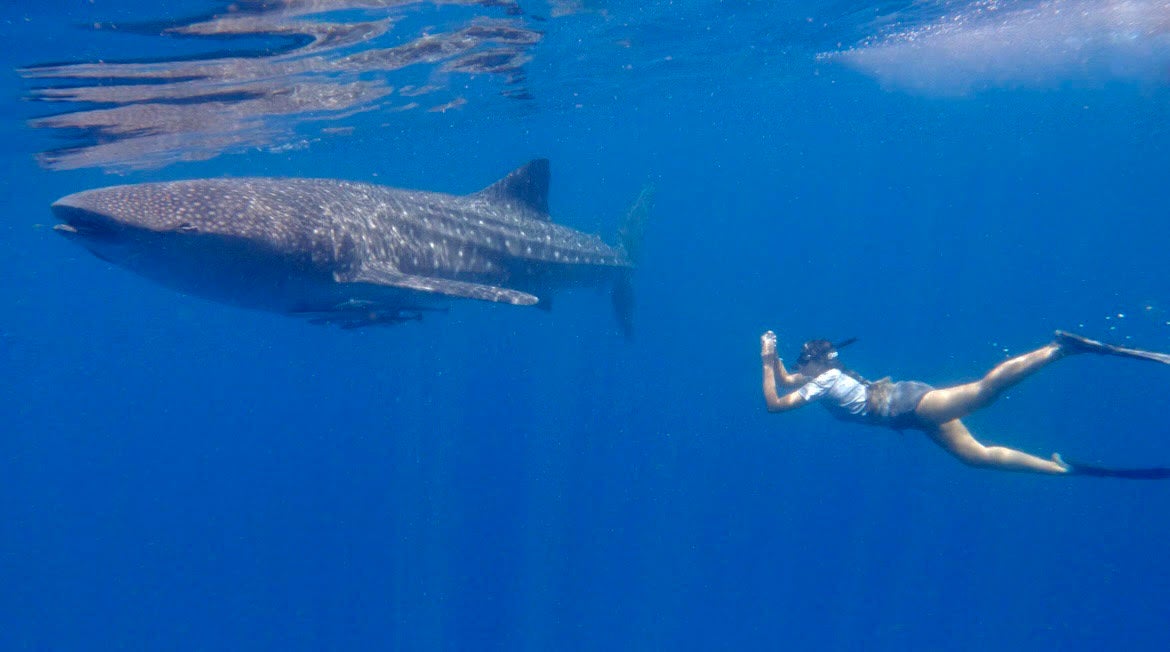In the series I Made a Big Mistake, PopSci explores mishaps and misunderstandings, in all their shame and glory.
With those two ominous notes, a 25-foot long mechanical great white shark named Bruce, and the menacing tagline “you’ll never go in the water again,” Jaws practically invented the summer blockbuster. It became the first film to gross over $100 million at the box office and put a young filmmaker named Steven Speilberg on the map. But along with some of the most quotable lines in movie history, it induced a societal fear of sharks as mindless monsters that hunt people with virtually indiscriminate taste and threaten seaside communities. Since then, both the author of the original novel and Spielberg have expressed some remorse over their mega-hit creation.
[Related: Great white shark sightings are up in the US, which is kind of good news.]
Peter Benchley’s 1974 novel of the same name has sold over 20 million copies. It drew from Benchley’s life-long fascination with the sea, that he took into his shark conservation work. His novel and the subsequent film were both loosely inspired by a series of shark encounters along the Jersey Shore in July 1916. The tales of what locals dubbed the Matawan Maneater were products of the early 20th century, when ocean swimming was new and sharks were still misunderstood by the general public and scientists alike. This confusion continued when Benchley first wrote the novel.
“I couldn’t write Jaws today. The extensive new knowledge of sharks would make it impossible for me to create, in good conscience, a villain of the magnitude and malignity of the original.”
Peter Benchley, 1995
In the March 1995 issue of Popular Science magazine Benchley wrote, “My research for the book was thorough and good…for its time. I read papers, watched all the documentaries, talked to all the experts. I realize now, though, that I was very much a prisoner of traditional conceptions. And misconceptions. I couldn’t write Jaws today. The extensive new knowledge of sharks would make it impossible for me to create, in good conscience, a villain of the magnitude and malignity of the original.”
Almost three decades later in a 2022 interview with BBC Radio, Speilberg joined his former collaborator in expressing the regret for the terrible reputation sharks are facing due to the film. The 76 year-old director said he feels responsible for the shark’s troubles in the almost 50 years since the film’s release.
“I still fear… that sharks are somehow mad at me for the feeding frenzy of crazy sword fishermen that happened after 1975,” said Spielberg. “I really, truly regret that.” The film has been blamed for leading to trophy hunting for sharks through the United States, due to its misrepresentation of great whites.
The destruction has only continued in the nearly two decades since Benchley died in 2006. A 2021 study found that the population of sharks and rays decreased by over 71 percent between 1970 and 2018 worldwide. Even as their numbers drop, an estimated 100 million sharks are killed per year and roughly 37 percent of sharks and rays are threatened with extinction largely from overfishing and shark finning.
“We only conserve what we love.”
The fear certainly presents itself as more fictionalized than reality-based at this point. Despite only killing 11 people worldwide in 2021 in isolated incidents, 96 percent of shark films still play into that fear and portray the fish as imminently threatening mass murderers. To help combat these stark exaggerations, shark researcher Heidy Martinez–who is affiliated with Minorities in Shark Science and is currently surveying a shark pupping nursery in the Gulf of Mexico as part of NOAA’s GULFSPAN project–utilizes her psychology background in her marine biology work. She uses empathy and understanding as starting points to try to change the relationship humans have with sharks.
“A fear of predators is normal and it’s healthy. It allows for respect, but that irrational fear of sharks also created a generation of people with galeophobia,” Martinez tells PopSci. “It’s so hard to correct because it targets emotions. It targets feelings and that is so much harder to change than logic.”
[Related: Great whites don’t hunt humans—they just have blind spots.]
She says acknowledging that fear, particularly the fear that a great white shark is going to repeatedly come after you Jaws-style, can be reframed with the knowledge that there are only three species out of roughly 500 sharks that are known to inflict serious injuries on humans and most sharks are only about three feet long.
“I don’t feel like Jaws is solely responsible for the decimation of the shark population… People did not care to love sharks because of what they saw in the media, so there wasn’t a push for society to step in and help sharks.”
Heidy Martinez
Martinez also cites a 1968 quote attributed to Senegalese forestry engineer Baba Dioum with respect to how shark conservation can historically be viewed. “In the end we will conserve only what we love; we will love only what we understand; and we will understand only what we are taught.”
 Heidy Martinez swims in Honda Bay in Palawan, Philippines on October 5, 2022. She is taking a photo ID of a juvenile whale shark to record behavioral data and assess population size. CREDIT: LAMAVE (Large Marine Vertebrates Research Institute Philippines)
Heidy Martinez swims in Honda Bay in Palawan, Philippines on October 5, 2022. She is taking a photo ID of a juvenile whale shark to record behavioral data and assess population size. CREDIT: LAMAVE (Large Marine Vertebrates Research Institute Philippines)
These misconceptions about sharks coincide with devastation of shark habitats and overfishing that are putting their existence in jeopardy. Misunderstanding sharks came at a very inopportune time.
“I don’t feel like Jaws is solely responsible for the decimation of the shark population. I think overfishing was going to happen with or without it,” she says. “I think the role that it did play was that it made people have a misunderstanding of sharks. People did not care to love sharks because of what they saw in the media, so there wasn’t a push for society to step in and help sharks.”
Changing tastes
Martinez and Woods Hole Oceanographic Institution fish ecologist Simon Thorrold both point to numbers as examples of why getting attacked and eaten by a shark is so unlikely.
Thorrold uses the recently exploding white shark hotspot around the waters of Cape Cod in Massachusetts as a prime example of how well white sharks get out of the way of humans.
“We might have hundreds of white sharks go by the Cape every year and we’ve got thousands of people in the water, some wearing black wetsuits on surfboards that look very similar to their natural prey. And yet, the odds of any kind of interaction are vanishingly small,” Thorrold tells PopSci.
[Related: Sharks are learning to love coastal cities.]
They do not eat humans like lions can and have also proven to be more discriminate in their tastes and have better eyesight than scientists initially believed. The sharks that share these northern waters with humans also have significantly more to fear from us. People too are slowly rehabilitating the sharks’ image. Cape Cod is potentially home to the largest concentrations of white sharks in the world, yet its ocean-conscious community and its leaders aren’t running out and attacking their aquatic neighbors with harpoons.
“A juvenile white shark basically got stranded on the Cape and a whole bunch of people showed up that were keeping the shark wet. They got it back into the water and it swam off,” he says. “Those are the kinds of interactions that we have come to expect when whales or dolphins strand, but to see it for a white shark sort of made my heart skip a beat. It’s sort of evidence of a much more mature relationship that the public has with our wild ocean fauna.”
Encounters with a full grown white shark, however, aren’t exclusively wholesome. They can be fatal due to the way the sharks ambush their prey using intense speed and the element of surprise. In 2018, Massachusetts had its first fatality since 1936 off the coast of Cape Cod, in a day that “changed Cape Cod forever.” Despite the immense tragedy when it occurs, dying from a shark attack remains exceedingly rare. According to NOAA, people are three times more likely to be struck by lightning than by a shark and data from the Florida Museum shows that dog attack fatalities are five times more common than shark bites.
From monster to making it right
Despite Peter Benchley’s remorse over his fearsome novel and its legacy, he has since worked directly on shifting the perception of the sharks. His conservation and advocacy work shone a spotlight on reality. Along with his wife Wendy Benchley, Peter traveled the world speaking with scientists and conservationists, lending their time, resources, and talents to preserving the animals that helped earn him fame and fortune.
In his 2006 obituary in The New York Times, Wendy recounted that many of the letters that Peter received were from people who read his novel when they were younger who went on to become marine biologists or science teachers, and that the generation after Jaws found it a great adventure story instead of a monster story.
Peter lived long enough to see this pivot in popular opinion, but the mistakes made at the expense of sharks is one that would be wise to remember.
“The mistake we make, then, either in seeking to destroy sharks or in not caring if we even inadvertently destroy them, is one of cosmic stupidity,” he wrote in 1995. “If I have one hope, it is that we will come to appreciate and protect these wonderful animals before we manage, through ignorance, stupidity, and greed, to wipe them out altogether.”
>>> Read full article>>>
Copyright for syndicated content belongs to the linked Source : Popular Science – https://www.popsci.com/environment/jaws-sharks-attack/































